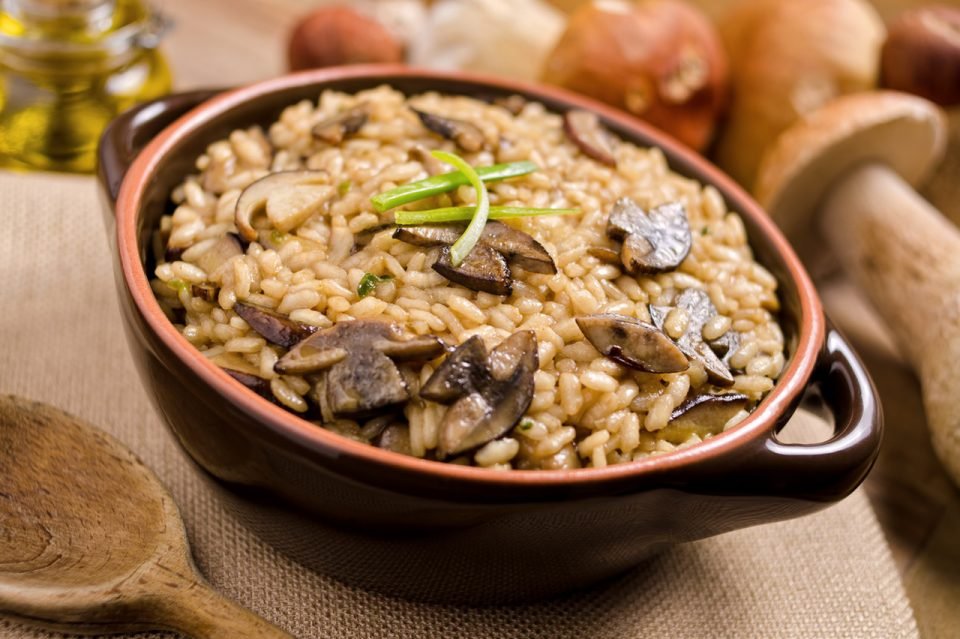
Mushroom Risotto
Mushroom risotto is a luxurious and delightful dish that you can prepare in under an hour, assuming that your mushrooms are already cleaned and ready to use. The flavor of the risotto is significantly elevated by using porcini or other wild European mushrooms such as trumpet or chanterelle varieties. These can be found at reasonable prices in one-pound bags from wholesale suppliers. While fresh wild mushrooms sautéed in butter offer fantastic taste, they might be too expensive for many and are only available during certain seasons. Truly wild mushrooms impart exceptional flavor. On the other hand, portobello, cremini, shiitake, or other cultivated types, regardless of how exotic they may seem, are not considered “wild,” even if some menus list them as such. Cooking risotto demands close attention at the stove for about twenty to twenty-five minutes until it’s perfectly done.
Ingredients
This recipe is adaptable—though it calls for 2 cups of rice, you can use 1 cup of rice and adjust the other ingredients accordingly. The complete recipe serves 8 generous appetizer portions.
– 1–2 ounces dried porcini (or other dried wild European mushrooms)
– Unsalted butter and olive oil for cooking, plus a couple of tablespoons for serving
– 1 cup water, heated for reconstituting the dried mushrooms, then set aside
– 2 large shallots or half a large sweet onion, finely chopped
– 3 cloves garlic, finely chopped
– 2 cups short-grain rice (arborio or carnaroli)
– 1 cup dry white wine (such as sauvignon blanc, but not chardonnay)
– 2 teaspoons kosher salt
– Pepper to taste
– 2 teaspoons dried thyme
– 5–7 cups of hot water or low-sodium vegetable stock (do not use chicken stock)
– 1–2 cups fresh mushrooms, sautéed until the liquid evaporates and they brown (such as cremini, portobello, or white button mushrooms, but avoid using Asian varieties like shiitake)
– 1 cup or more freshly grated parmigiano-reggiano cheese
Preparation
Begin by preparing all the ingredients, including the hot stock and sautéed mushrooms. Avoid using any domestic or non-traditional cheese unless necessary for kosher reasons. Soak the dried European wild mushrooms (such as porcini, trumpets, and/or chanterelles) in the hot water until they soften. Carefully lift them from the liquid, leaving behind any sand, and keep the liquid. Allow the reserved soaking liquid to rest so any sediment can settle at the bottom. Roughly chop the reconstituted mushrooms and set aside.
In a mixture of about 2 tablespoons of butter and olive oil, lightly sauté the onion and garlic along with the rice. Continue sautéing the rice until it appears slightly translucent and is completely coated with the oil and butter. Then, deglaze the pot with the white wine, allowing it to evaporate and absorb before adding any other liquid. Add 1 teaspoon of salt for each cup of rice, along with the thyme and pepper to taste.
Stir the rice frequently, letting it simmer gently, and do not leave it unattended on the stove. As the wine reduces, start adding another cup of liquid, beginning with the mushroom soaking liquid but leaving out the sediment. Incorporate the chopped reconstituted mushrooms and continue stirring while gradually adding vegetable stock until the rice is thoroughly cooked. To determine if it’s done, taste it; the texture should be creamy rather than crunchy. Near the end of cooking, fold in the previously sautéed fresh mushrooms. When the rice is cooked to your liking, turn off the heat and mix in the grated parmesan cheese (at least 1 cup or more) and a couple of tablespoons of butter. The risotto should not be overly stiff but should remain slightly soupy.
As an alternative twist, consider adding snow peas, sugar snap peas, or asparagus (peeled and cut into 1-inch pieces) a few minutes before finishing cooking. These vegetables should remain bright green and slightly crisp, not overcooked.
Serve the risotto promptly while hot, alongside a fresh salad.
Editor’s Note: Recipe courtesy of Kenneth M. Horwitz, author of Deep Flavors: A Celebration of Recipes for Foodies in a Kosher Style. The book is available for purchase at www.deepflavorscookbook.com or on Amazon and Kindle.








